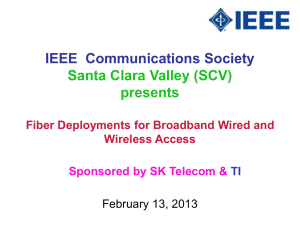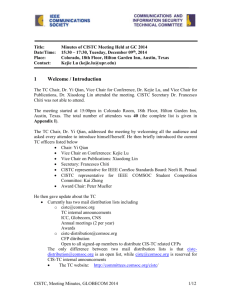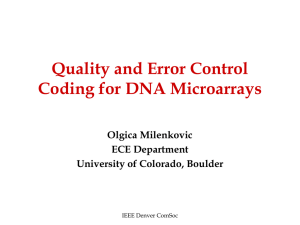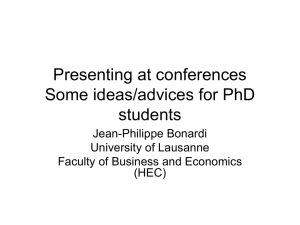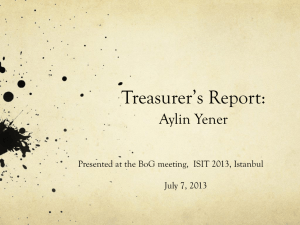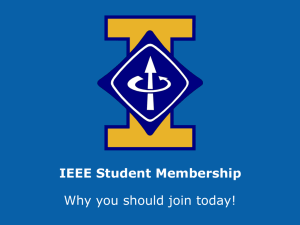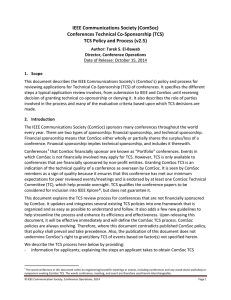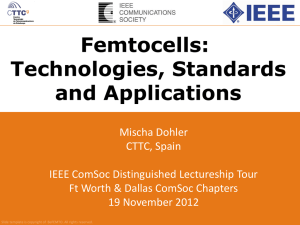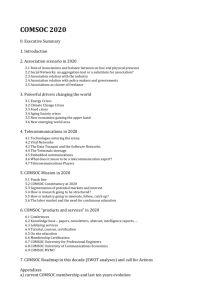ComSoc`s Technical Scope - IEEE Communications Society
advertisement
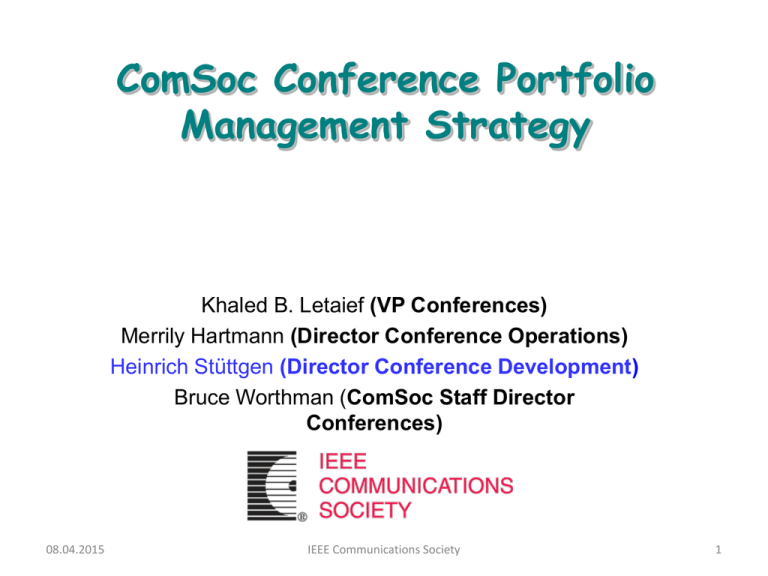
ComSoc Conference Portfolio Management Strategy Khaled B. Letaief (VP Conferences) Merrily Hartmann (Director Conference Operations) Heinrich Stüttgen (Director Conference Development) Bruce Worthman (ComSoc Staff Director Conferences) 08.04.2015 IEEE Communications Society 1 Objectives 1. Understand whether/how ComSoc Conferences serve our constituency and the scientific community in terms of: – Technical merit, quality, coverage of ComSoc‘s field of interest – Membership development – Financial contribution - Today and tomorrow 2. Identify steps to improve the value of ComSoc‘s conference portfolio – Find optimal rules and processes to improve the value proposition of ComSoc Conferences (per class) – Define a portfolio development strategy to • incubate and • Phase out, or • Collaborate with other organizations according to a defined strategy 3. Provide means to communicate the conference development strategy to the technical community/TAC 4/8/2015 IEEE Communications Society 2 Outline I. Explain the different categories of conferences and their main characteristics II. Coverage analysis of current portfolio (financially sponsored) events and conclusions III. Explain the chosen KPI (Key Performance Indicator) structure IV. Summary 08.04.2015 IEEE Communications Society 3 I. Conference Categories TCS Events Regional Events Co-Sponsored Confs Workshops Core Events Flagships + Incubators 08.04.2015 IEEE Communications Society 4 I. Conference Categories 1. Flagships – – – – – – – Large Attendance Extensive Coverage of ComSoc Technical Scope Many (if not all) TCs involved Significant ComSoc Project Management Co-located ComSoc Governance Meetings International Audience Surplus requirement >= 20% 2. Core – – – – – – – – – 08.04.2015 Significant event - targeting to achieve 200+ attendees Medium to Significant ComSoc Project Management Usually multiple tracks May have specific TC involvement/support Surplus requirement >= 20% International based Targeted Audience Long-term life cycle (proposed > 10 years) Normally Annual Covers subset (but not all) of ComSoc Technical Scope IEEE Communications Society 5 I. Conference Categories 3. TC Workshops and TC driven (smaller) Confs – Event often driven by one TC (decision maker) (Steering Committee Charter often linked to TC Charter but involvement by other TCs possible) – Minimal ComSoc Project Management – Surplus requirement 10% (due to reduced overhead) – Typically < 100 attendees and 1 or 2 tracks Events 4. (Financially) Co-Sponsored Confs – Any size from small to very very big – Facilitates collaboration with other societies having fields of interest overlapping with ComSoc – Varying levels of ComSoc Project Management (depending on co-sponsor) – Always a sharing of the surplus with a 20% target – Managing Society may vary 08.04.2015 IEEE Communications Society 6 I. Conference Categories 5. Regional – – – – – – – – – Extend ComSoc Reach Conference always occurs in a Specific Region (Country) Conference titles derived from a flagship or core conference, must include the name of the region (country) in the conference title but may include "international“ e.g. IEEE Communications Conference in <region> - following the ICC/GLOBECOM Involvement of IEEE Sections and Chapters, TCs, and ComSoc sister society preferred Objective is membership development (may co-locate RCCCs, governance meetings) Main target is new members in that region - conference attendance expected to be greater than 50% from that region (country) May Include new program elements to promote community building Varying levels of ComSoc Project Management Surplus requirement target may depend on strength of region, partnership model, project management needs – 10% (developing region), 20% (North America, Europe, Japan, Pacific) 6. Incubators – – “Start-ups" must be moved to other category after 2 completed events Surplus requirement: 10% 7 I. Conference Categories Objective Attendance Flagship • broadest technical coverage & quality • surplus • governance meetings Core • technical coverage of sub-scope • high quality • surplus Small Conf/TC WS • technical community networking • quality Regional • membership development Co-op • collaborate rather than compete with other societies/organisations Incubator • extend technical scope of conf. portfolio TCS • collaboration • building relationships 08.04.2015 Surplus Req Region 20% typically 200K$ US and around the world 20% Moving around the world <= 100 10% Moving around the world > 200 10 or 20% by region Fixed region 20% Moving around the world 10% Moving around the world n.a. Moving around the world 8 > 1000 100 < n <1000 vary 20 < n < 100 vary IEEE Communications Society II.ComSoc‘s Technical Scope (Horizontal layered View) Business Aspects Services and Applications Network Management & Control Networking Wireless/Radio Optical PwLC Signal Processing Communication Theory 08.04.2015 IEEE Communications Society 9 08.04.2015 IEEE Communications Society Comm.s SW Modelling and Simulation QoS, Reliability, Dependability Security Energy Efficieny & Smart Grids Multimedia eHealth & other applications Sensor NW - RFID - M2M/IoT Vehicular Networks and ITS II. Vertical areas 10 II. Total Coverage Wireless/Radio Networking Optical Comm.s SW Security Network Management & Control Modelling and Simulation QoS, Reliability, Dependability Energy Efficieny & Smart Grids Services and Applications Multimedia eHealth & other applications Sensor NW - RFID - M2M/IoT Vehicular Networks and ITS Business Aspects PwLC Signal Processing Communication Theory 08.04.2015 IEEE Communications Society 11 II. Geographic Scope – Regional Conferences ?Rus ? ?EU ? ICCC ANTS ?Afr ? ATC-REV ?LA ? ?PA ? • Today we don‘t have many regional conferences strategy or portfolio • Need strategy for large developing regions like China, India, LA 08.04.2015 IEEE Communications Society 12 III. KPI Scheme Objectives of KPI (Key Performance Indicator) Scoring • Understand the contribution and value of our conferences • Hopefully hHelp conferences to identify opportunities for improvement • Help to improve efficiency and value of conference in aspects like scope, financial, overhead/cost ... • Facilitate a strategy for creating, mergingco-locating, abandoning conferences, or moving them from portfolio to TCS • Create conferences addressing current gaps in our portfolio • Evaluating criteria: Financial, attendance, technical area, quality, popularity III. Attendee Satisfaction Based on suggestions from the ComSoc Board of Governors discussion we added „Attendee Satisfaction“ The way to evaluate conferences regarding community satisfactions are the questionnaires recently introduced So far only a few conferences have delivered the past event evaluations – so this indicator shpould be added later when more data becomes available, at this time it will only distort the picture So far we have only a few results: – WCNC = 4.22 , INFOCOM = 4.12, ICC = 4.09, DySpan = 4.26 GLOBECOM = 4.17, SmartGridComm = 4.05 – If all events score >4, we need to reconsider either the thresholds (how to assign scores) or modify/sharpen the questionnnaires Hence: Work in progress IEEE Communications Society 16 III. KPIs Key Performance Indicators Conference Scoring -1 0 1 2 3 0-40K 40-80K Profit (absolute) loss 0< X < 20 20<X50 50<X<100 >100 K$ Profit (%) loss 0<X<10 10<X<20 20<X<25 >25% Absolute Number 0 - 30 30 - 60 60-90 90 - 200 >200 3 Yr Trend (2 last periods) >-20% -5 - -20% -5 - +5% +5 - +20% >+20% leading unique Financial (3 yr avg) Absolute Number (Revenue) 80-120K 120K-200K >200K Attendance Technical Scope Unique vs Clustered crowded overlapping one of two Quality/Popularity (Average of last 2 to 3 years) Acceptance Ratio >75% 50 - 75% 35 - 50% 25 - 35% < 25% Xplore Downloads per paper 0 – 15 16 – 30 31 – 45 46 – 60 60 08.04.2015 Attendee Satisfaction IEEE Communications Society <2 2 3 4 >4 17 Summary In 2011 ComSoc adopted a portfolio-based management strategy for its financially sponsored conferences This slide set tries to explain – the approach chosen for evaluating the value of individual conferences – the terminology used in the process The method evaluates ComSoc conferences from many different aspects, e.g. quality, attendance, financial perfomance, etc The conference portfolio management is a tool to identify gaps, rising stars and conferences with improvement opportunities in our conference portfolio – There is no threshold defined stating that a conference needs to achieve a given minimal score – Scores help to identify strengths and weaknesses of a given conference to help organizers/steering committees identify improvement opportunities Details of the conference scores are available to the respective steering committees 08.04.2015 IEEE Communications Society 18
